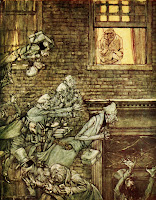Jolabokaflod, the Christmas Book Flood, is here. It may also be the perfect holiday celebration. Typically celebrated on Christmas Eve, it involves giving and getting chocolate, wearing your snuggliest pajamas, and it involves exchanging books and reading them all night! But what scary offerings should people read while the wind (or something worse) howls outside? Whether you are looking for some scary offerings or celebrating your own Jolabokaflod with a horror fan, here are some good choices that are easy to digest while also full of frights.
Jolabokaflod is a night of reading, but it can also be reading to get done in a night, and short story anthologies are perfect for this. Much like a tin of Danish cookies, these collections are teeming with variety. Two really good anthologies that are sure to not only get you into the Christmas spirit but summon a few Christmas spirits are Hark the Herald Angels Scream and A Midnight Clear. Hark the Herald Angels Scream features stories from well-known horror authors like Christopher Golden, Josh Malerman, and elder horror statesman Joe Lansdale and covers holiday horrors ranging from Christmas carols to demonic toys, homegrown American horrors to horrors abroad. A Midnight Clear features some newer authors but also has some more traditional horrors like visits to Santa’s workshop to a visit from the demons of Christmas Past, Present, and Future. These cold stories will make you want to sit closer to the fire . . . and maybe lock the door.
Looking for something longer to sink your teeth into but something that could be read in one cold, dark night? Novellas are the way to go, and there are plenty of good novellas out there. Looking forward to indulging in something delicious? Sara Tantlinger’s novella To Be Devoured features a woman flirting with strange appetites in a desolate part of the country. Country Christmases can be peaceful, but it also means that help can’t reach you in time. Looking to spend time with family or friends? Brian Keene’s With Teeth features a group of friends out hiking in the woods. Friendship is a pretty powerful bond, but anyone who knows vampires, like these men will, knows that blood is thicker. Worried about your presents arriving on time? Consider reading about a similar service to Amazon, except its packages are victims for a budding serial killer in Stephen Graham Jones’s The Least of My Scars. Whatever your interest this holiday, celebrate Jolabokaflod with some good chocolate and some great scares. Stay warm and stay scary, my friends.


